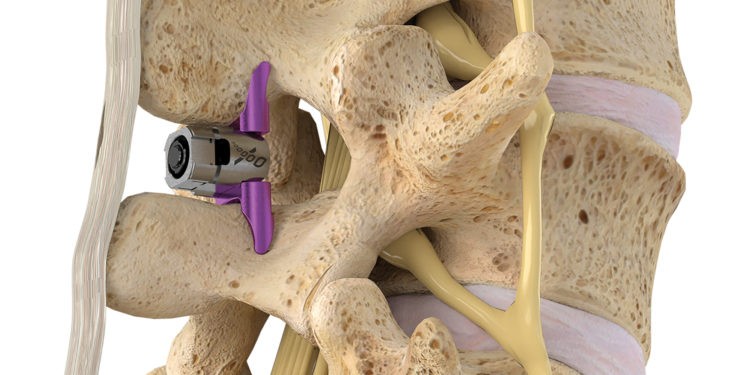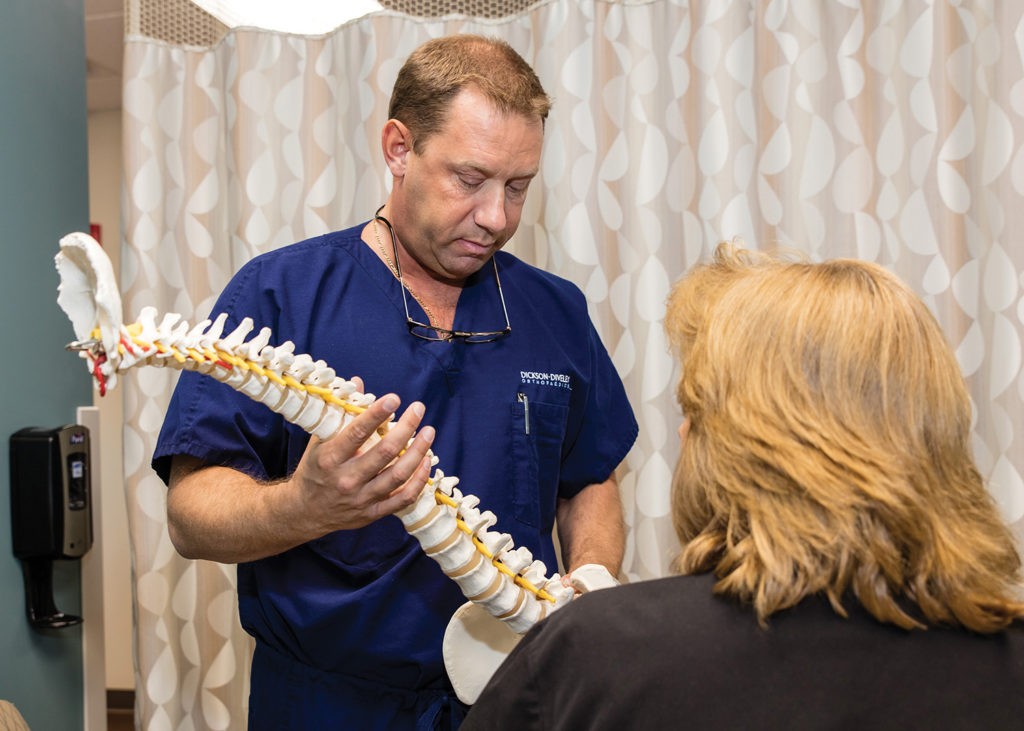Revolutionizing the Treatment of Spinal Stenosis

The Vertiflex Procedure with C. Lan Fotopoulos, M.D. of Dickson-Diveley Orthopaedics
If pain from mild to moderate spinal stenosis is keeping you from enjoying a more active lifestyle, Superion® by Vertiflex® may have a solution.
The lumbar spine is made up of five bones called vertebrae. Between each of the vertebrae are discs which provide necessary cushion for spinal rotation and bending. These are referred to as intervertebral discs. Each disc is comprised of a fibrous outer layer called the annulus fibrosus and a soft, gelatinous center called nucleus pulposos. These work together to allow the spine to bend and twist and allow for shock absorption. When the spinal canal becomes narrow and begins to compress the nerves that travel through the lower back to the legs, this is known as lumbar spinal stenosis. Common symptoms of this condition include pain in the legs or lower back when standing or walking. It can also include numbness and a tingling sensation that radiates from the lower back down into the buttocks, legs and calves. Patients may experience pain in both legs, or the pain may be worse in one leg than the other. The discomfort is typically relieved when sitting, lying down, or leaning forward.

If you or someone you know suffers from lumbar spinal stenosis, you know how debilitating it can be. You may not be able to pursue the once-active lifestyle you enjoyed due to chronic pain, cramping, weakness and/or numbness, and as a result, comfort and mobility can be adversely affected. While medication, physical therapy and surgery are all potentially viable methods of treatment, sometimes these do not provide the necessary relief patients need.
We can blame age and the accompanying wear and tear of our bodies from daily activities on this condition. As we age, so does our spine. According to the American Academy of Orthopedic Surgeons, degenerative changes of the spine are seen in up to 95% of people by the age of 50. However, spinal stenosis is most frequently seen in patients over 60 years of age and most frequently seen in men. Symptoms, though, can appear as early as age 30 due to developmental causes.
While there are several treatment options available for lumbar spinal stenosis, including over-the-counter non-steroidal anti-inflammatory drugs, heat, massage, spinal injections and physical therapy. Spine surgery may be considered if those non-operative therapies are ineffective or if a patient’s symptoms continue to progress. Many patients, however, cannot tolerate the more invasive approaches or simply are not good candidates for such therapies. Thanks to a new treatment option known as the Vertiflex Procedure, many patients are discovering the joy that comes with getting back to doing the things they love to do most with the least amount of disruption to their lives as possible.
Time to Reimagine Treatments for Spinal Stenosis: Introducing Superion by Vertiflex
The Vertiflex Procedure involves the Superion Indirect Decompression System, a relatively new, minimally invasive approach to treating lumbar stenosis. The Vertiflex Procedure is a FDA approved and clinically proven, minimally invasive solution intended to deliver timely, long-term relief from the pain associated with lumbar spinal stenosis (LSS). It is a relatively simple outpatient procedure that treats the stenosis by making space for affected nerves in the spine, which may help to alleviate back and leg pain that often accompanies the condition.
Patients who are deemed as candidates for the Superion by Vertiflex Procedure are now given the chance to re-embrace the active lifestyles they once enjoyed. Developed with the patient safety and comfort in mind, the Vertiflex Procedure aims to give stenosis suffers the freedom to move freely and pursue their daily lives.
 One of the local providers of this procedure is C. Lan Fotopoulos, M.D., an interventional physiatrist with Dickson-Diveley Orthopaedics. Dr. Fotopoulos stands as one of ten metro-area physicians who is certified in this procedure which has been designed to provide the most advanced and least invasive treatment for mild to moderate lumbar spinal stenosis.
One of the local providers of this procedure is C. Lan Fotopoulos, M.D., an interventional physiatrist with Dickson-Diveley Orthopaedics. Dr. Fotopoulos stands as one of ten metro-area physicians who is certified in this procedure which has been designed to provide the most advanced and least invasive treatment for mild to moderate lumbar spinal stenosis.
“The company (Vertiflex) is only going to certify 400 physicians in the United States to keep this in the hands of people who are technically good at this procedure,” indicated Dr. Fotopoulos.

The Superion is designed to preserve your mobility while still providing the stability your spine requires.
Impressive Efficacy
This procedure involves single-use instruments through a streamlined process with a reduced risk of infection and maximized patient safety. The FDA-regulated trial demonstrated a significant reduction in symptoms, along with marked improvement in function and clinical efficacy durable to 60 months. It is the preferred treatment on the continuum of care between conservative care and surgery.
“Nothing has this five-year data like Vertiflex,” emphasized Dr. Fotopoulos.
Vertiflex maintains a commitment to excellence and efficacy which allowed this company to conduct the most rigorous FDA clinical trial for lumbar stenosis. Superion is proven to be durable for up to 60 months, providing patients with a reduction in leg pain by 75% at 60 months.

How Does It Work?
The Superion Indirect Decompression System involves a small implant that creates space for the nerves along the spine. The idea behind it is to alleviate back and leg pain typically associated with this condition. This minimally invasive procedure implants the small titanium device through a small tube roughly the size of a dime. Single-use instruments are used through a streamlined process to reduce risk of infection and maximize patient safety. It is an outpatient procedure that can be done in a hospital or in an outpatient surgical center with rapid recovery.
While the benefits may be noticed immediately, at least half of Dr. Fotopoulos’ patients realize a positive difference within four to six weeks post-surgery.
“Yes, some patients do have immediate relief, but they can still have the post-operative pain from the small (one-half to one-inch) incision,” stated Dr. Fotopoulos.
Initial limiting of activity levels may be recommended by Dr. Fotopoulos and then increase with time as the patient heals.

Who is the Ideal Candidate?
According to Dr. Fotopoulos, the Vertiflex Procedure may be ideal for patients with moderate spinal stenosis who have tried six months of conservative treatment with no relief and for whom traditional spinal surgery is too demanding.
“Most of my patients are in their 70s, although we have done this procedure on some who are in their 80s and 90s,” he noted.
When consulting with patients about this procedure, Dr. Fotopoulos refers to a list of certain criteria that he believes should be met in order to indicate Vertiflex as a potential treatment option.
“A qualified patient may complain of back and leg pain that is relieved with sitting but irritated when walking or standing,” said Dr. Fotopoulos. “Of course, we have to rule out that the pain is not associated with something else, so we do an MRI of the patient’s back, and if it is stenosis, then we can proceed.”
Dr. Fotopoulos further noted Vertiflex is ideal for a patient who is adamantly opposed to the more invasive approaches or if the stenosis is not advanced enough for surgery or if the patient overall is just not a good surgical candidate.
“This is a relatively simple procedure to do and can be done with local or twilight anesthesia,” said Dr. Fotopoulos. “It takes about 20 minutes to perform and there is no disruption to the bone or the surrounding tissue. It does not involve any bolting, rods, screws or wires.”

Are There Any Risks?
As with any procedure, there can be certain risks associated with it. Dr. Fotopoulos can determine if the Vertiflex Procedure is right for you. For the most part, however, the benefits can outweigh any adverse limitations.
“This procedure helps the vast majority of patients,” noted Dr. Fotopoulos. “However, the implant is removable if it is not helping the patient. From my experience, eighty-five percent of patients see improvement.”
Although the Vertiflex Procedure can be a great option for some patients, Dr. Fotopoulos emphasized it is not necessarily the first “go-to” when it comes to treating lumbar spinal stenosis.
“At first, we might recommend physical therapy, medication or epidural injections. If those are unsuccessful, then we may consider performing the Vertiflex Procedure.”
If none of the aforementioned options provide relief for the patient, then Dr. Fotopoulos might suggest a major surgical procedure, such as a laminectomy.

Reduction in Pain, Reduction in Opioid Use and Patient Satisfaction Numbers Run High
The company continues to collect data to demonstrate the long-term effectiveness of this minimally-invasive treatment, including a 75% reduction in leg pain, an 85% drop in opioid use and 90% patient satisfaction rate at five years following the procedure.
“I enjoy doing this procedure, as it is truly rewarding to see my patients pain-free and getting back to their active lifestyles,” smiled Dr. Fotopoulos, who treats patients with this procedure at the Dicksen-Diveley facility in Leawood, Kansas, as well as St. Luke’s Hospital on the Plaza and at St. Luke’s Hospital South in Overland Park, Kansas.
While patients may have their activity levels limited initially, Dr. Fotopoulos will review post-operative guidelines with each patient and advise as to how to increase activity levels as the patient heals.







